
The Lincoln Experimental Satellite series was designed and built by Lincoln Laboratory at Massachusetts Institute of Technology between 1965 and 1976, under USAF sponsorship, for testing devices and techniques for satellite communication.

The Lincoln Experimental Satellite series was designed and built by Lincoln Laboratory at Massachusetts Institute of Technology between 1965 and 1976, under USAF sponsorship, for testing devices and techniques for satellite communication.
After the successful development and deployment of Project West Ford, a passive communications system consisting of orbiting copper needles, MIT's Lincoln Laboratory turned to improving active-satellite space communications. In particular, Lincoln aimed to increase the transmission capability of communications satellites ("downlink"), which was necessarily constrained by their limited size. After receiving a charter in 1963 to build and demonstrate military space communications, Lincoln focused on a number of engineering solutions to the downlink problem including improved antennas, better stabilization of satellites in orbit (which would benefit both downlink and "uplink"—communications from the ground), high-efficiency systems of transmission modulation/de-modulation, and cutting-edge error-checking techniques. [1] : 81–83
These experimental solutions were deployed in a series of nine spacecraft called Lincoln Experimental Satellites (LES). Concurrent with their development, Lincoln also developed the Lincoln Experimental Terminals (LET), ground stations that used interference-resistant signaling techniques that allowed use of communications satellites by up to hundreds of users at a time, mobile or stationary, without involving elaborate systems for synchronization and centralized control. [1] : 81–83
The 1st, 2nd, and 4th satellites in the LES series were designated "X-Band satellites," designed to conduct experiments in the X band, the military's super high frequency (SHF) band (7 to 8 GHz) [2] : 160 because solid-state equipment allowed for comparatively high output in this band, and also because the band had been previously used by West Ford. [1] : 83–84
The series had satellites named LES-1 through LES-9. They suffered a number of launch problems - LES-1 and LES-2 were supposed to be delivered to the same 2,800 x 15,000 km orbit, [3] though a failure of a boost stage left LES-1 in a 2,800 km circular orbit. LES-3 and LES-4 were intended to be delivered to geostationary orbit, but a launch problem left them in their transfer orbit. All these satellites returned useful results despite the incorrect orbits. LES-5, -6, -8 and -9 ended up successfully in geostationary orbit; the project that would have been LES-7 ran out of funding and was cancelled. [4] [LES-9 was in an elliptical orbit in the mid-1980s and was used by environmental buoys to communicate data out of the very high northern latitudes. (Geostationary satellites are not visible at those latitudes as they are below the horizon.)]
LES-3 was a very small (16 kg) satellite containing a radio transmitter, intended to measure the extent of multi-path interference due to reflection of 300 MHz radio waves off sufficiently flat parts of the Earth.
Amongst the technologies tested on LES-1 through LES-4 were solid-state X-band radio equipment, low-power logic circuits, electronic despinning (using optics to determine the location of the Earth and Sun relative to a spinning satellite at any moment, and then transmitting via whichever of several antennae were best positioned with respect to the Earth), and magnetic torquers. [5]
LES-8 and LES-9 were satellites of around 450 kg mass, launched on March 14, 1976. They were originally planned to be equipped with pulsed plasma engines but actually launched with gas thrusters; unusually for communication satellites, they are powered by MHW-RTGs rather than by solar panels. [6] There was a cross-link between them in the 36–38 GHz part of the K band, with UHF up- and down-links; they are still operated, and the cross-link technology is used by NASA's TDRSS satellites. The original intention was to run the cross-link at a frequency in the 55–65 GHz range, which is absorbed by water, so that it would be impossible for Earth-based receivers to pick up scattered signals, but technology at the time was inadequate. They operated in geostationary orbit until 1992 and now are drifting slowly.
Lincoln Laboratory's next satellite-communication project after LES was the construction of FLTSAT EHF Packages.
| Name | COSPAR ID | Launch | Reentry |
|---|---|---|---|
| LES-1 | 1965-008C | 11 Feb 1965 | |
| LES-2 | 1965-034B | 6 May 1965 | |
| LES-3 | 1965-108D | 21 Dec 1965 | 6 Apr 1968 |
| LES-4 | 1965-108B | 21 Dec 1965 | 19 Aug 1970 |
| LES-5 | 1967-066E | 1 Jul 1967 | |
| LES-6 | 1968-081D | 26 Sep 1968 | |
| LES 7 | |||
| LES-8 | 1976-023A | 15 Mar 1976 | |
| LES-9 | 1976-023B | 15 Mar 1976 | |
| Sources: [7] [8] | |||
Amateur radio enthusiasts were able to detect the radio signals emitted from LES-1 at the end of 2012 and the telemetry of LES-5 in 2020. [9]

A geostationary orbit, also referred to as a geosynchronous equatorial orbit (GEO), is a circular geosynchronous orbit 35,786 km (22,236 mi) in altitude above Earth's equator, 42,164 km (26,199 mi) in radius from Earth's center, and following the direction of Earth's rotation.

A communications satellite is an artificial satellite that relays and amplifies radio telecommunication signals via a transponder; it creates a communication channel between a source transmitter and a receiver at different locations on Earth. Communications satellites are used for television, telephone, radio, internet, and military applications. Many communications satellites are in geostationary orbit 22,300 miles (35,900 km) above the equator, so that the satellite appears stationary at the same point in the sky; therefore the satellite dish antennas of ground stations can be aimed permanently at that spot and do not have to move to track the satellite. Others form satellite constellations in low Earth orbit, where antennas on the ground have to follow the position of the satellites and switch between satellites frequently.

The Goldstone Deep Space Communications Complex (GDSCC), commonly called the Goldstone Observatory, is a satellite ground station located in Fort Irwin in the U.S. state of California. Operated by NASA's Jet Propulsion Laboratory (JPL), its main purpose is to track and communicate with interplanetary space missions. It is named after Goldstone, California, a nearby gold-mining ghost town.
The Ka band is a portion of the microwave part of the electromagnetic spectrum defined as frequencies in the range 26.5–40 gigahertz (GHz), i.e. wavelengths from slightly over one centimeter down to 7.5 millimeters. The band is called Ka, short for "K-above" because it is the upper part of the original NATO K band, which was split into three bands because of the presence of the atmospheric water vapor resonance peak at 22.24 GHz (1.35 cm), which made the center unusable for long range transmission. The 30/20 GHz band is used in communications satellite uplinks in either the 27.5 GHz or 31 GHz bands, and in high-resolution, close-range targeting radars aboard military airplanes. Some frequencies in this radio band are used for vehicle speed detection by law enforcement. The Kepler Mission used this frequency range to downlink the scientific data collected by the space telescope.
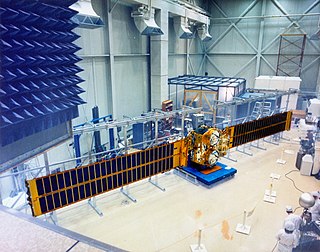
The Communications Technology Satellite (CTS), known as Hermes, was an experimental high-power direct broadcast communications satellite. It was a joint effort of Canadian Department of Communications, who designed and built the satellite, NASA who tested, launched and operated the satellite, and European Space Agency (ESA) who provided the 1200 watts solar panels and other devices. The three agencies shared the satellite and the data from the experiments.

ATS-6 was a NASA experimental satellite, built by Fairchild Space and Electronics Division It has been called the world's first educational satellite as well as world's first experimental Direct Broadcast Satellite as part of the Satellite Instructional Television Experiment between NASA and Indian Space Research Organisation (ISRO). It was launched May 30, 1974, and decommissioned July 1979. At the time of launch, it was the most powerful telecommunication satellite in orbit. ATS-6 carried no fewer than 23 different experiments, and introduced several breakthroughs. It was the first 3-axis stabilized spacecraft in geostationary orbit. It was also the first to use experimentally with some success electric propulsion in geostationary orbit. It also carried several particle physics experiments, including the first heavy ion detector in geostationary orbit.
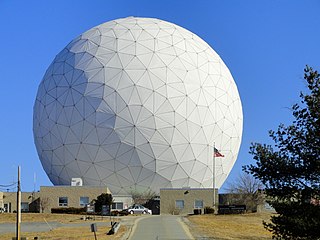
Haystack Observatory is a multidisciplinary radio science center, ionospheric observatory, and astronomical microwave observatory owned by Massachusetts Institute of Technology (MIT). It is in Westford, Massachusetts, in the United States, about 45 kilometers (28 mi) northwest of Boston. The observatory was built by MIT's Lincoln Laboratory for the United States Air Force and was called the Haystack Microwave Research Facility. Construction began in 1960, and the antenna began operating in 1964. In 1970 the facility was transferred to MIT, which then formed the Northeast Radio Observatory Corporation (NEROC) with other universities to operate the site as the Haystack Observatory. As of January 2012, a total of nine institutions participated in NEROC.
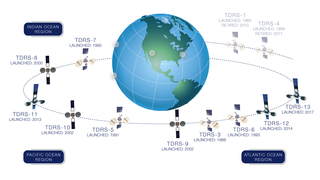
A tracking and data relay satellite (TDRS) is a type of communications satellite that forms part of the Tracking and Data Relay Satellite System (TDRSS) used by NASA and other United States government agencies for communications to and from independent "User Platforms" such as satellites, balloons, aircraft, the International Space Station, and remote bases like the Amundsen-Scott South Pole Station. This system was designed to replace an existing worldwide network of ground stations that had supported all of NASA's crewed flight missions and uncrewed satellites in low-Earth orbits. The primary system design goal was to increase the amount of time that these spacecraft were in communication with the ground and improve the amount of data that could be transferred. These TDRSS satellites are all designed and built to be launched to and function in geosynchronous orbit, 35,786 km (22,236 mi) above the surface of the Earth.

Badr-A was the first artificial and the first digital communications satellite launched by Pakistan's national space authority — the SUPARCO — in 1990. The Badr-A was Pakistan's first indigenously developed and manufactured digital communications and an experimental artificial satellite which was launched into low Earth orbit by Pakistan on 16 July 1990, through a Chinese carrier rocket. The launch ushered new military, technological, and scientific developments in Pakistan and also provided data on radio-signal distribution in the ionosphere. Originally planned to be launched from the United States in 1986, the Challenger disaster further delayed the launch of the satellite which changed the plan. After the People's Republic of China offered Pakistan to use its facility, the Badr-A was finally launched from Xichang Satellite Launch Center in 1990 on Long March 2E. Badr-A travelled at 17,500 miles per hour (28,200 km/h), taking 96.3 minutes to complete an orbit, and emitted radio signals at the 145 to 435 MHz bands which were operated by Pakistan Amateur Radio Society (PARS). The Badr-A successfully completed its designed life, and a new satellite was proposed to be developed.

Project West Ford was a test carried out by Massachusetts Institute of Technology's Lincoln Laboratory on behalf of the United States military in 1961 and 1963 to create an artificial ionosphere above the Earth. This was done to solve a major weakness that had been identified in military communications.

Satellite television is a service that delivers television programming to viewers by relaying it from a communications satellite orbiting the Earth directly to the viewer's location. The signals are received via an outdoor parabolic antenna commonly referred to as a satellite dish and a low-noise block downconverter.
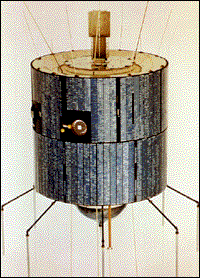
Applications Technology Satellite 3, or ATS-3, was a long-lived American experimental geostationary weather and communications satellite, operated by NASA from 1967 to 2001. It was at one time reputed to be the oldest satellite still in operation. As of 1995, NASA referred to the ATS-3 as "The oldest active communications satellite by a wide margin."
The Intelsat VI series of satellites were the 8th generation of geostationary communications satellites for the Intelsat Corporation. Designed and built by Hughes Aircraft Company (HAC) in 1983-1991, there were five VI-series satellites built: 601, 602, 603, 604, and 605.

The Laser Communications Relay Demonstration (LCRD) is a NASA mission that will test laser communication in space for extremely long distances, between Earth and geosynchronous orbit.

The ACTS Gigabit Satellite Network was a pioneering, high-speed communications satellite network in the years 1993-2004, created as a prototype system to explore high-speed networking of digital endpoints. The system was jointly sponsored by NASA and ARPA, implemented by BBN Technologies and Motorola, and was inducted into the Space Technology Hall of Fame in April 1997.
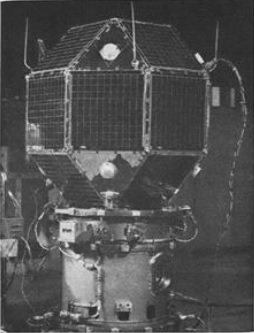
Lincoln Experimental Satellite 1, also known as LES-1, was a communications satellite, the first of nine in the Lincoln Experimental Satellite program. Launched by the United States Air Force (USAF) on February 11, 1965, it pioneered many then-advanced technologies including active use of the military's SHF band to service hundreds of users. LES-1 did not have a successful operational life due to being placed in a suboptimal orbit, and it ceased transmissions in 1967. After 45 years of inactivity, LES-1 spontaneously resumed transmissions in 2012 making it one of the oldest zombie satellites.

Lincoln Experimental Satellite 2, also known as LES-2, was a communications satellite, the second of nine in the Lincoln Experimental Satellite. Launched by the United States Air Force (USAF) on 6 May 1965, it demonstrated many then-advanced technologies including active use of the military's SHF band to service hundreds of users.

Lincoln Experimental Satellite 3, also known as LES-3, was a communications satellite, the third of nine in the Lincoln Experimental Satellite. Launched by the United States Air Force (USAF) on 21 Dec 1965, it was stranded in a Geostationary Transfer Orbit rather than its planned circular high orbit. Despite this, LES-3 returned good data on communications propagation in the UHF band.

Lincoln Experimental Satellite 4, also known as LES-4, was a communications satellite, the fourth of nine in the Lincoln Experimental Satellite, and the first of the series designed for operations at geosynchronous altitudes. Launched by the United States Air Force (USAF) on 21 December 1965, it demonstrated many then-advanced technologies including active use of the military's SHF band to service hundreds of users.

The Initial Defense Communications Satellite Program or IDCSP was the first United States Department of Defense communications satellite constellation and the first stage of the Defense Communications Satellite Program (DCSP). Launched in five groups by Titan IIIC launch vehicles to near equatorial, subsynchronous orbits between 1966 and 1968, they were intended to be experimental testbeds. They were so successful that, by the time of the launch of the last set of eight satellites, the IDCSP was deemed operational and renamed Initial Defense Satellite Communications System or IDSCS. This system allowed real-time collection of battlefield intelligence during the Vietnam War. A total of 35 IDCSP satellites were launched, 27 successfully.